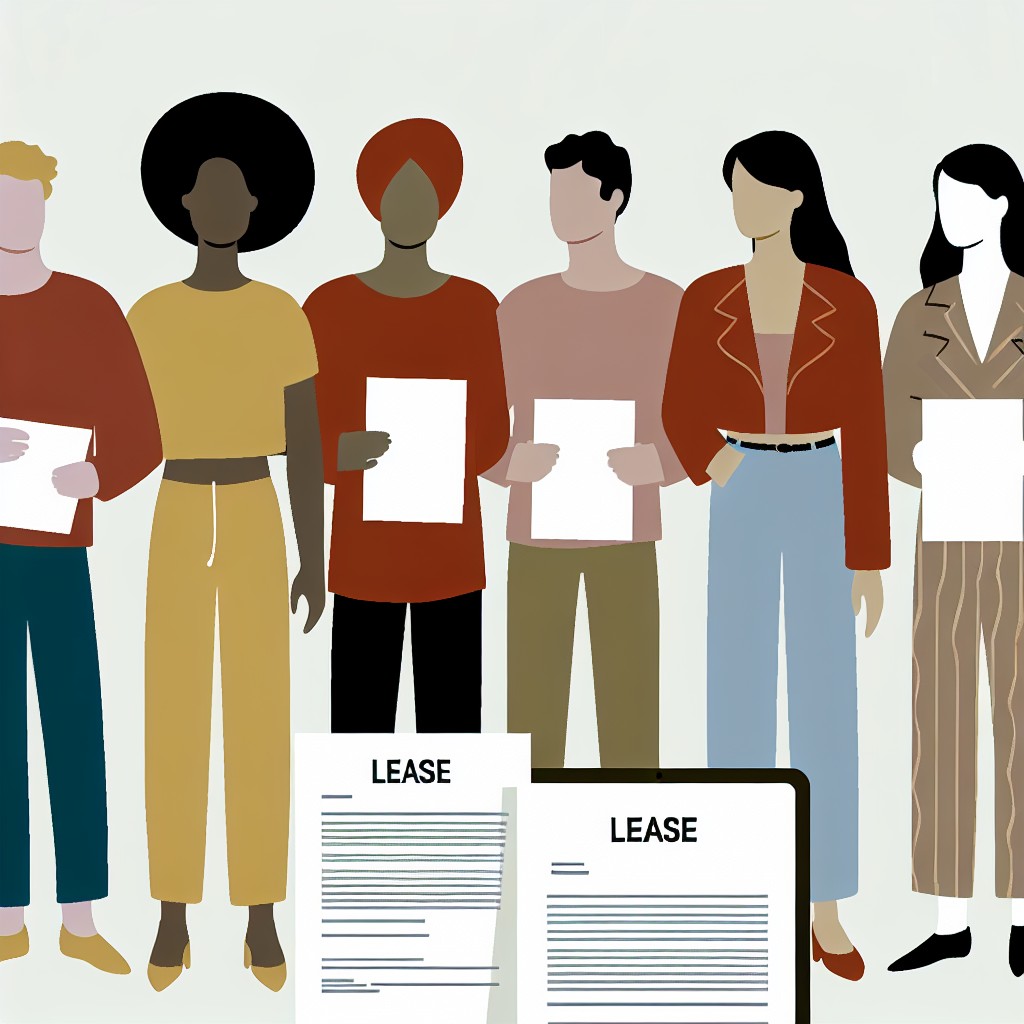Introduction to Lease Agreements in Shared Housing
Lease agreements play a crucial role in shared housing arrangements.
They provide a framework for cohabitating individuals to share their living space.
Understanding these agreements helps prevent disputes and fosters harmony.
Key Components of Lease Agreements
First, lease agreements outline the duration of the tenancy.
This duration can vary from short-term to long-term leases.
Additionally, these agreements specify the rent amount and payment terms.
It is essential to understand how utilities and other expenses are handled.
Moreover, rules regarding shared spaces should be clearly defined.
This information includes how common areas are maintained and used.
Responsibilities of Housemates
Each housemate should be aware of their responsibilities.
This includes keeping their private and shared areas clean.
Furthermore, they must adhere to agreed-upon quiet hours.
Communication is vital in maintaining a respectful living environment.
Regular meetings can help address any concerns and resolve conflicts.
Legal Implications of Lease Agreements
Lease agreements provide legal protection for all parties involved.
They outline the rights and responsibilities of each tenant.
Understanding these legalities can prevent potential eviction cases.
Additionally, it is wise to consult a lawyer for clarity on specific terms.
Approaches to Negotiating Lease Terms
Negotiating lease terms is essential for establishing a comfortable co-living arrangement.
Open dialogues about rent and responsibilities foster cooperation.
Potential tenants should feel empowered to request modifications.
This allows them to address unique needs and preferences.
Enhancing Shared Living with Lease Agreements
Lease agreements form the backbone of shared housing arrangements.
They promote transparency and clarity among housemates.
When correctly understood and implemented, they enhance the living experience.
Key Components of Co-Living Lease Contracts
Defining Living Arrangements
A co-living lease must clearly define living arrangements.
This includes shared versus private spaces.
Also, specify the types of amenities available.
Responsibilities of Tenants
Tenants must understand their responsibilities.
These often include paying rent and utility bills.
Furthermore, cleaning and maintenance tasks can be shared.
Duration of the Lease
Clearly state the lease duration in the agreement.
This can range from months to several years.
Include details about renewal options as well.
Rent Payment Terms
Every lease should specify the rent amount.
Include payment methods for convenience.
Additionally, state the due date each month.
Note any penalties for late payments.
Security Deposits
Include information regarding security deposits.
Explain how much will be collected upfront.
Also, define conditions for returning the deposit.
House Rules
Enforce house rules to maintain harmony.
These rules can cover noise levels and guest policies.
Include guidelines on smoking and pet ownership.
Termination Conditions
Clearly articulate conditions under which a lease may terminate.
This includes notice periods and reasons for eviction.
Address the process for lease termination as well.
Dispute Resolution
Include a section on resolving disputes among tenants.
This can suggest mediation or arbitration methods.
Moreover, have procedures in place for grievance reporting.
Insurance Considerations
Encourage tenants to acquire renters insurance.
This protects personal belongings in shared living spaces.
Clearly state any insurance requirements in the lease.
Legal Considerations Specific to Shared Housing Rentals
Understanding Lease Agreements
Lease agreements set the foundation for shared housing arrangements.
They outline the terms and conditions that both parties must follow.
Moreover, it is crucial to ensure clarity in these agreements.
Ambiguities can lead to disputes down the line.
Key Components of a Lease Agreement
Each lease agreement should include essential components.
- Names of all tenants and landlords involved.
- The total rental amount and payment schedule.
- Duration of the lease, including renewal terms.
- Responsibilities for maintenance and repairs.
- Rules for subletting and guests.
Tenant Rights and Responsibilities
Tenants have specific legal rights in shared housing.
They include the right to a safe living environment.
In addition, tenants should know their responsibilities.
These often involve maintaining shared spaces and paying rent on time.
Landlord Obligations
Landlords also have legal obligations toward their tenants.
They must provide a habitable living space.
Additionally, they should ensure that all appliances and utilities work properly.
Failure to meet these obligations could result in legal action.
Dispute Resolution Methods
Disputes may arise in shared housing situations.
Having a clear process for resolution is crucial.
- Consider mediation services for conflict resolution.
- Written documentation of issues is essential.
- Know the local tenancy laws to protect your rights.
Importance of Understanding Local Laws
Each region has specific housing laws that govern rentals.
Researching these laws helps both landlords and tenants.
This ensures compliance with local regulations.
Stay informed about changes to housing laws as well.
Gain More Insights: Guide to Handling Lease Violations and Tenant Noncompliance
Rights and Responsibilities of Roommates and Landlords
Understanding Rights of Roommates
Each roommate has the right to enjoy their living space peacefully.
They deserve access to shared amenities like kitchens and bathrooms.
Roommates have the right to a fair allocation of living expenses.
They should receive proper notice before any changes in lease terms.
Roommates must have an understanding of house rules.
Responsibilities of Roommates
Roommates must pay their share of rent promptly each month.
They should contribute to common household chores regularly.
Open communication is crucial among all roommates.
Respecting quiet hours is essential in maintaining harmony.
Roommates need to be mindful of shared spaces and belongings.
Rights of Landlords
Landlords have the right to receive rent payments on time.
They can establish and enforce rules for their properties.
Landlords have the right to conduct inspections with proper notice.
They have the authority to address damages caused by tenants.
Landlords must maintain the property in a habitable condition.
Responsibilities of Landlords
Landlords must ensure that all maintenance issues are addressed promptly.
They should provide a safe living environment for all tenants.
Landlords must respect tenants’ privacy and quiet enjoyment.
They have a legal obligation to comply with local housing laws.
Landlords must respond to tenant complaints in a timely manner.
Gain More Insights: Fair Housing Laws for Property Managers
Best Practices for Negotiating Co-Living Lease Terms
Understanding Lease Agreements
Lease agreements outline the terms of tenancy for shared housing arrangements.
They include details such as the duration and total rent due.
It is crucial to read the lease thoroughly before signing.
Taking your time minimizes misunderstandings and future disputes.
Researching Market Standards
Start by researching local rental trends and average prices.
This information helps you gauge a fair rental amount.
Furthermore, being informed empowers you during negotiations.
Collect data about comparable properties in the area.
Defining Shared Responsibilities
Clearly lay out shared responsibilities in the lease agreement.
This may include maintenance, utility payments, and cleaning duties.
Specify how costs will be divided among housemates.
Establishing these roles avoids conflicts later on.
Negotiating the Lease Terms
When negotiating, be assertive but respectful.
Present your research on local market rates to support your position.
Listen actively to the landlord’s perspective on lease costs.
This approach fosters a cooperative atmosphere.
Reviewing and Updating the Lease
Before signing, review all terms carefully with your housemates.
Make sure everyone agrees on the stipulations outlined in the lease.
If necessary, request updates or modifications to the document.
For instance, it may be important to adjust terms related to guests.
Seeking Legal Assistance
If unsure about legal jargon, consider consulting a lawyer.
A legal professional can clarify complex terms and conditions.
Additionally, they can help you identify any potential pitfalls.
Investing in legal assistance can save you from costly mistakes.
Discover More: Property Management Licensing and Legal Requirements

Understanding Security Deposits and Payment Structures
Importance of Security Deposits
Security deposits provide protection for landlords against potential damages.
They ensure that tenants take care of the property during their stay.
Additionally, deposits can cover unpaid rent if necessary.
Understanding the specific amount and terms is crucial for both parties.
Typical Amounts for Security Deposits
Most often, security deposits equal one month’s rent.
However, some landlords may charge up to two months’ rent based on property condition.
Comparing local market practices aids in setting an appropriate deposit amount.
Payment Structures in Co-Living Arrangements
Co-living arrangements typically involve shared payment responsibilities.
Rent is often split among tenants to make it more affordable.
Additionally, some agreements may include utilities within the rent amount.
This structure promotes transparency in financial responsibilities.
Setting Up Payment Processes
Clear guidelines should define payment processes in lease agreements.
Establish deadlines for monthly payments to avoid confusion.
Using online payment systems can streamline the payment process.
Moreover, keeping records of transactions is essential for accountability.
Legal Considerations for Security Deposits
Landlords must follow local laws regarding security deposits.
Some regions require landlords to deposit funds into a separate account.
Understanding these regulations protects both landlords and tenants.
Always outline return conditions for security deposits in the lease.
Resolving Disputes Over Security Deposits
Disputes can arise regarding the return of security deposits.
Clear communication can often resolve misunderstandings before escalation.
If disputes occur, mediation services may help reach a fair solution.
In complex cases, legal advice might be necessary to navigate disagreements.
Discover More: Lease Agreements for Homeowners Renting a Room
Resolving Disputes Among Co-Living Residents
Understanding Common Disputes
Conflict can arise in shared living situations.
Common disputes include noise levels.
Cleanliness causes disagreements.
Shared expenses also cause conflicts.
Residents often disagree over personal habits.
Preferences differ among co-living residents.
Recognizing these issues early prevents escalation.
Establishing Clear Communication
Open dialogue is essential for resolution.
Residents should feel comfortable expressing their concerns.
Regular house meetings facilitate this communication.
Using a group messaging app enhances discussions.
Creating a Conflict Resolution Plan
A clear plan provides structure during disputes.
Include steps for addressing issues as a household.
For example, establish rules for mediation.
Designate a neutral party to help navigate conflicts.
Outline consequences for repeated issues.
Involving Third Parties
Sometimes outside help is necessary for resolution.
Consider consulting a mediator specializing in co-living disputes.
A professional offers unbiased perspectives and solutions.
Local resources may provide conflict resolution workshops.
Agreeing on Shared Responsibilities
Defining responsibilities helps minimize disputes.
Create a shared responsibilities list for daily tasks.
Ensure all residents agree on common areas and chores.
Rotate duties to promote fairness among housemates.
Reviewing the Lease Agreement
Your lease agreement should outline expectations clearly.
Review the terms related to conflict resolution procedures.
Understanding your rights and responsibilities guides actions.
Consult a legal expert for clarity if necessary.
Fostering a Positive Living Environment
Encouraging a respectful atmosphere benefits all residents.
Participate in community-building activities regularly.
Planning social events promotes understanding and connection.
Showing appreciation for each other fosters goodwill.
Trends in the Co-Living Market and Their Impact on Lease Agreements
Growth of Co-Living Spaces
The demand for co-living spaces has surged in urban areas.
Young professionals seek flexible and affordable accommodations.
Co-living offers a sense of community and shared resources.
Changing Demographics
Millennials and Gen Z increasingly prefer co-living arrangements.
These groups value social connectivity and collaborative living experiences.
Landlords must adapt to these preferences in lease agreements.
Lease Agreements in Co-Living Environments
Traditional lease agreements often fail to meet co-living needs.
Landlords are revising lease templates to accommodate shared housing.
Shorter lease terms are becoming popular to attract tenants.
Legal Considerations in Co-Living Arrangements
Lease agreements must address shared responsibilities among roommates.
Landlords should clarify liability for damages and communal spaces.
Legal compliance regarding occupancy limits is essential.
Technological Integration
Many co-living spaces leverage technology for management and communication.
Online platforms streamline the lease signing and payment processes.
This tech integration enhances the tenant experience significantly.
Impact of Economic Factors on Co-Living Trends
The real estate market’s volatility affects co-living trends.
During economic downturns, demand for affordable shared living increases.
Landlords must adjust lease terms to remain competitive in fluctuating markets.
Additional Resources
A landlord wants to sign a Co-Living Agreement rather than a rental …
Residential Tenants’ Rights Guide | New York State Attorney General




